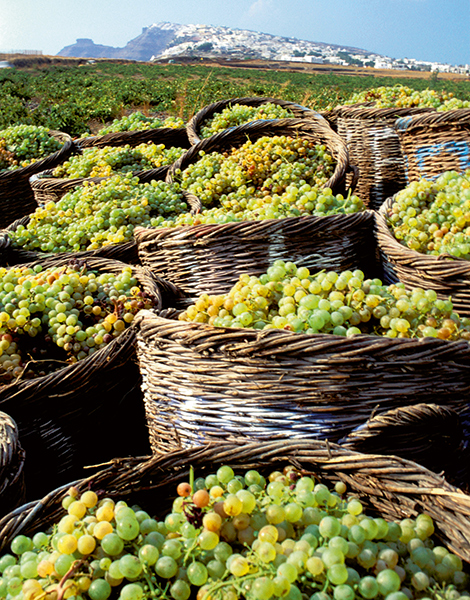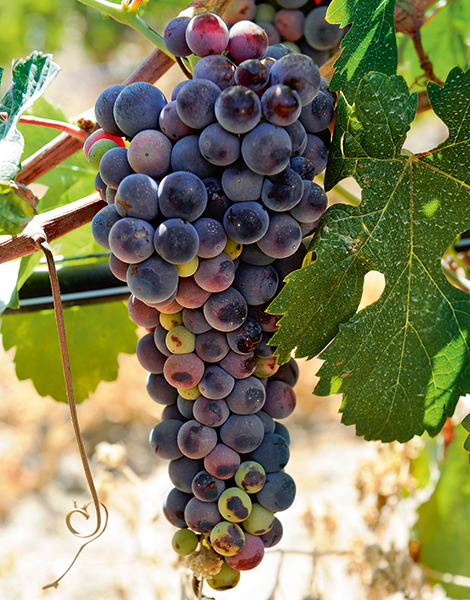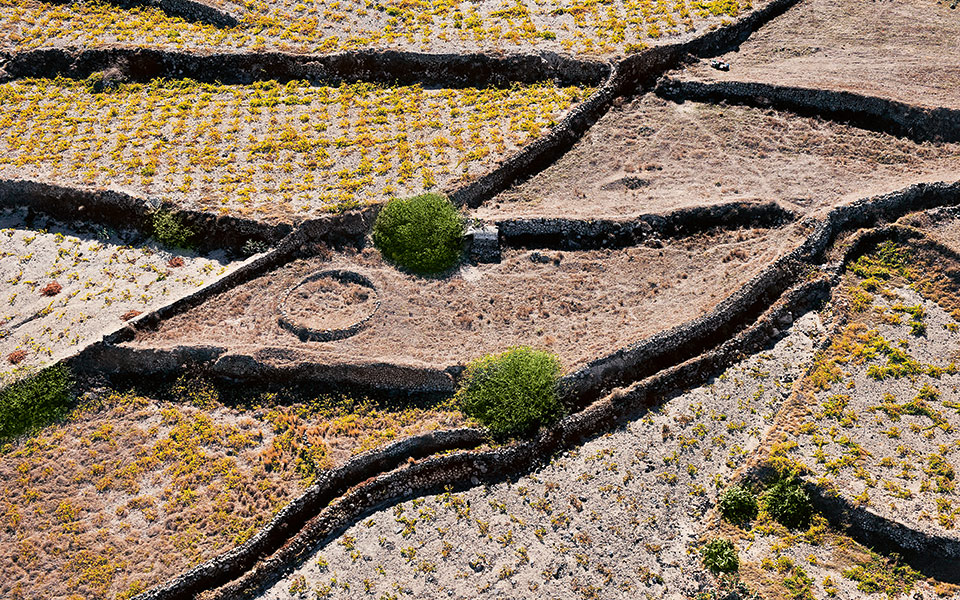Wild, windswept and arid, it is not easy for vines to flourish on Santorini. They must contend with scorching daytime temperatures, high humidity at night in spring and summer, an almost total lack of rainfall and, above all, fierce winds. And these aren’t the only difficulties facing the island’s viniculturalists. The vineyards themselves are relatively small and yields are poor. Only 1,400 hectares are still being cultivated and the average production per hectare is low (2,500-3,500 kg) in comparison to the rest of Greece (10,000 kg).
Only hard work can improve the odds. Santorini’s vintners still harvest the grapes by hand and weave the nests in which the fruit of the vine hatches, sticking to the age-old pruning technique of the “kouloura,” by which vines are trained into continuous circles to form a basket offering protection from the strong winds and harsh summer sun. Pruning takes them four times longer than with a common trellis system and infinitely longer to handpick the grapes at harvest time – yet they persist.
Why? Quite simply because they have a rare terroir. The seemingly adverse conditions and the volcanic soil create an environment in which the island’s celebrated native varieties – Assyrtiko, Santorini’s flagship grape that occupies about 70% of the vineyards, but also Athiri, Aidani, Mandilaria and Mavrotragano – can unveil their unique character.
Santorini quite possibly has the oldest vineyards in the world under continuous cultivation. The vines were planted 3,500 years ago and have never been uprooted. The island is immune to phylloxera, the 19th-century epidemic that ravaged vineyards and erased countless grape varieties in continental Europe, and thus boasts vines that are centuries-old.
“ Santorini quite possibly has the oldest vineyards in the world under continuous cultivation. The vines were planted 3,500 years ago and have never been uprooted. ”

© VisualHellas.gr

© Vangelis Zavos
It was not long before the intriguing story of these almost supernatural vineyards was embraced by contemporary sommeliers, wine critics and wine merchants who were looking for something different. In the early 1990s, the island’s winemakers one after the other started to abandon the bulk approach and invest in what was to be a fascinating combination of respect for tradition and commitment to quality wine-making.
“These wines promise adventure. The payoff is not merely the pleasure of discovery, but the affirmation that even jaded palates can find something new,” wrote Eric Asimov in 2012. The chief wine critic for the New York Times, who can strike fear into even the biggest wine producers on the planet, had chosen to taste – along with an impressive wine panel – 20 Greek reds, among them the 2008 Atlantis from Argyros on Santorini.
INFO
The varieties in the vinicultural zone with the Protected Designation of Origin (PDO) SANTORINI are three whites (Assyrtiko, Atheri and Aidani). There are three PDO wines: Santorini and Nykteri (dry whites produced with a minimum of 75% Assyrtiko with the remaining 25% made up of Athiri and/or Aidani) and Vinsanto (produced with at least 51% Assyrtiko blended with Aidani, Athiri or other local varieties).
Assyrtiko from Santorini has racked up countless international awards including Wine Spectator scores in the 90s, a recent gold medal from Decanter (Britain’s equivalent of the Wine Spectator), and another gold medal from Bordeaux’s International Challenge of Wine.
This year, the Santorini vintners who participated in this year’s TexSom International Wine Awards, the most important wine competition in the USA, did very well indeed. Assyrtiko labels from the SantoWines, Gaia Wines and Domaine Sigalas wineries received gold and silver medals. A few months ago, Asimov was back, this time without hesitating to draw a highly favorable comparison between Assyrtiko and one of the world’s most popular Italian varieties. “I have nothing against Pinot Grigio,” he wrote, “but why should anybody who cares about what they eat and drink settle for familiar and icy rather than something full of character?” Asimov encouraged his readers to try Assyrtiko, likening its flavor to “the concentrated essence of millions of tiny seashells”!











